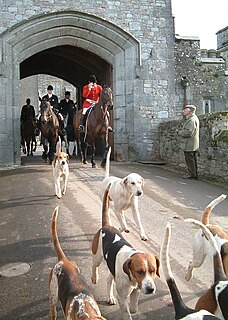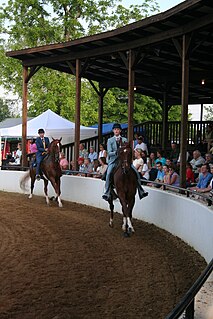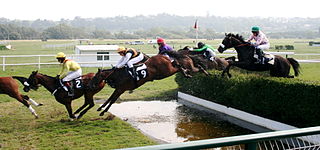This article needs additional citations for verification .(July 2015) (Learn how and when to remove this template message) |

A field hunter, or a fox hunter, is a type of horse used in the hunt field for fox hunting and stag hunting.
This article needs additional citations for verification .(July 2015) (Learn how and when to remove this template message) |

A field hunter, or a fox hunter, is a type of horse used in the hunt field for fox hunting and stag hunting.
The field hunter may be of any breed, but should possess stamina, a level head, and bravery. The horse should have a safe jump, so as not to get caught on any of the solid obstacles found in the hunt field. The type of terrain is also an important factor: wide open, flat land is generally best for horses of a Thoroughbred type, while rockier, more unforgiving land may be best suited by a draft-cross or tougher breed.
Field hunter trials are regularly held to test these horses, and have become a popular form of equestrian competition. Often the horses are judged over several days of fox hunting, with the best of the group performing in the "handy hunter" class. The handy hunter class may ask for the horse and rider pair to trot a log, open and close a gate while mounted, jump several fences, and for the rider to dismount and remount. The horse is judged on its manners, way of going, as well as its suitability as a hunter.
In some ways, the field hunter is more similar to a good cross-country horse seen in eventing than a show-ring hunter, as it must gallop and jump over varied terrain, jump ditches, coops, up and down banks, and occasionally go through water.
Unlike the field hunter, the horse known in the US as a show hunter and in the UK as a working hunter performs in a ring, usually over a course of 8-10 fences. The judging of the American show hunter is based on the requirements of a horse in the hunt field, focusing on the horse's manners, movement, jumping form, rhythm, and smoothness around the course. Show hunters in the US are usually warmblood or Thoroughbred types. They do not have to have the bravery required of the field hunter, nor do they travel over the same type of terrain, as the field or arena is usually fairly level. Although the fences in a show hunter course are usually "natural" poles and standards, as opposed to the brightly colored fences seen in show jumping, the show hunter course does not include rock walls, ditches, or banks that might be seen in the hunt field. The British working hunter is not required to jump obstacles exactly like those met in the hunting field, although a water tray is sometimes used to simulate a ditch, and natural dips in the ground, banks etc. are often incorporated into the course in order to make it more challenging.
Horses of field hunter type may also compete in certain race completions such as point-to-pointing. In the United Kingdom, with the exception of Hunt Members races, all the horses that compete in point-to-point must be registered by Weatherbys - in the General Stud Book or Non-Thoroughbred Register. Horses and jockeys must have qualified with a pack of foxhounds, harriers, bloodhounds or draghounds by "riding to hounds". Horses must be ridden to hounds on four or more occasions during the hunting season that immediately precedes the point-to-point season, and belong to a member, subscriber or farmer of a recognised pack. [1]

The Ibizan Hound is a lean, agile dog of the hound family. There are two hair types of the breed: smooth and wire. The more commonly seen type is the smooth. Some consider there to be a third type, long, but the longhair is most likely a variation of the wire.

Show jumping, also known as "stadium jumping", is a part of a group of English riding equestrian events that also includes dressage, eventing, hunters, and equitation. Jumping classes are commonly seen at horse shows throughout the world, including the Olympics. Sometimes shows are limited exclusively to jumpers, sometimes jumper classes are offered in conjunction with other English-style events, and sometimes show jumping is but one division of very large, all-breed competitions that include a very wide variety of disciplines. Jumping classes may be governed by various national horse show sanctioning organizations, such as the United States Equestrian Federation in the USA or the British Showjumping Association in Great Britain. International competitions are governed by the rules of the International Federation for Equestrian Sports. Horses are very well-known for jumping in competition or even freely.

Eventing is an equestrian event where a single horse and rider combine and compete against other competitors across the three disciplines of dressage, cross-country, and show jumping. This event has its roots in a comprehensive cavalry test that required mastery of several types of riding. The competition may be run as a one-day event (ODE), where all three events are completed in one day or a three-day event (3DE), which is more commonly now run over four days, with dressage on the first two days, followed by cross-country the next day and then show jumping in reverse order on the final day. Eventing was previously known as Combined Training, and the name persists in many smaller organizations. The term "Combined Training" is sometimes confused with the term "Combined Test", which refers to a combination of just two of the phases, most commonly dressage and show jumping.

Fox hunting is an activity involving the tracking, chase and, if caught, the killing of a fox, traditionally a red fox, by trained foxhounds or other scent hounds, and a group of unarmed followers led by a "master of foxhounds", who follow the hounds on foot or on horseback.

Equestrianism, commonly known as horse riding or horseback riding, includes the disciplines of riding, driving, or vaulting with horses. This broad description includes the use of horses for practical working purposes, transportation, recreational activities, artistic or cultural exercises, and competitive sport.

Cross country equestrian jumping is an endurance test that forms one of the three phases of the sport of eventing; it may also be a competition in its own right, known as hunter trials or simply "cross-country", although these tend to be lower-level, local competitions.
In horse racing in the United Kingdom, France and the Republic of Ireland, National Hunt racing requires horses to jump fences and ditches. National Hunt racing in the UK is informally known as "jumps" and is divided into two major distinct branches: hurdles and steeplechases. Alongside these there are "bumpers", which are National Hunt flat races. In a hurdles race, the horses jump over obstacles called hurdles; in a steeplechase the horses jump over a variety of obstacles that can include plain fences, water jump or an open ditch. In the UK the biggest National Hunt events of the year are generally considered to be the Grand National and the Cheltenham Gold Cup.

A horse show is a judged exhibition of horses and ponies. Many different horse breeds and equestrian disciplines hold competitions worldwide, from local to the international levels. Most horse shows run from one to three days, sometimes longer for major, all-breed events or national and international championships in a given discipline or breed. Most shows consist of a series of different performances, called classes, wherein a group of horses with similar training or characteristics compete against one another for awards and, often, prize money.

Equitation is the art or practice of horse riding or horsemanship.

"English pleasure" is the generic term for a number of different English riding classes seen at horse shows in the United States, where the horse is ridden in either hunt seat or saddle seat tack.

The Hunter division is a branch of horse show competition that is judged on the horse's performance, soundness and when indicated, conformation, suitability or manners. A "show hunter" is a horse that competes in this division.

Hunt seat is a style of forward seat riding commonly found in North American horse shows. Along with dressage, it is one of the two classic forms of English riding. The hunt seat is based on the tradition of fox hunting. Hunt seat competition in North America includes both flat and over fences for show hunters, which judge the horse's movement and form, and equitation classes, which judge the rider's ability both on the flat and over fences. The term hunt seat may also refer to any form of forward seat riding, including the kind seen in show jumping and eventing.

A point-to-point is a form of horseracing over fences for hunting horses and amateur riders. In Ireland, where the sport is open to licensed - i.e. professional - trainers, many of the horses will appear in these races before they compete in National Hunt races. Consequently, the Irish point-to-point is more used as a nursery for future young stars: a horse that wins its debut point-to-point in Ireland will often sell for a high price. Whilst professional trainers are specifically excluded from running horses in point-to-points in Great Britain, the days of the farmer running his hunter at the local point-to-point have gone. Increasingly, horses are run from "livery yards" - unlicensed but otherwise professional training establishments, sometimes closely allied with a licensed yard.

A steeplechase is a distance horse race in which competitors are required to jump diverse fence and ditch obstacles. Steeplechasing is primarily conducted in Ireland, the United Kingdom, Canada, United States, Australia and France. The name is derived from early races in which orientation of the course was by reference to a church steeple, jumping fences and ditches and generally traversing the many intervening obstacles in the countryside.

The Hortaya borzaya is an old Asian sighthound breed originating in the former Kievan Rus, later Grand Duchy of Lithuania and Russian Empire. It is a dog of large size, of lean but at the same time robust build, of considerably elongated proportions. In its everyday life the hortaya is quiet and balanced. It has a piercing sight, capable of seeing a moving object at a very far distance. In spite of its calm temperament the dog has a very active reaction to running game. Hortaya are excellent, enduring hunting dogs endowed with a good, basic obedience and completely lacking aggression towards humans.

A cob is traditionally a draft type pony. Should be of a stout build, with strong bones, large joints, and steady disposition; it is a body type of horse rather than a specific breed. Historically, in the United Kingdom and, to a lesser extent, the eastern United States, a 'cob' may be a common horse used for everyday riding but in the past was used for driving carts.

The show hack is a type of ridden show horse, exhibited to a standard first established in England.
Equestrian Canada, formerly known as Equine Canada and commonly known by its acronym, EC, is Canada’s comprehensive national governing body for equestrian sport. It is the executive branch of Canada's Olympic and Paralympic equestrian teams; the national association and registry of Canadian equestrian athletes; the national regulatory body for equestrian coaches, competition organizers, and judges; and the national federation of Canadian horse breeders and Canadian breed registries.
Various obstacles are found in competitive sports involving horse jumping. These include show jumping, hunter, and the cross-country phase of the equestrian discipline of eventing. The size and type of obstacles vary depending on the course and the level of the horse and rider, but all horses must successfully negotiate these obstacles in order to complete a competition. Fences used in hunter and eventing are generally made to look relatively rustic and natural.
The German Hound is a breed of dog originating in Westphalia, a region of Germany. The German Hound is of the scenthound type, used for hunting both large and small game.